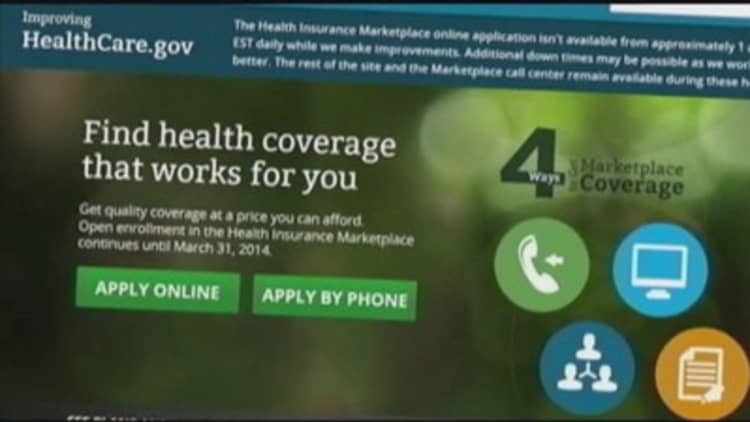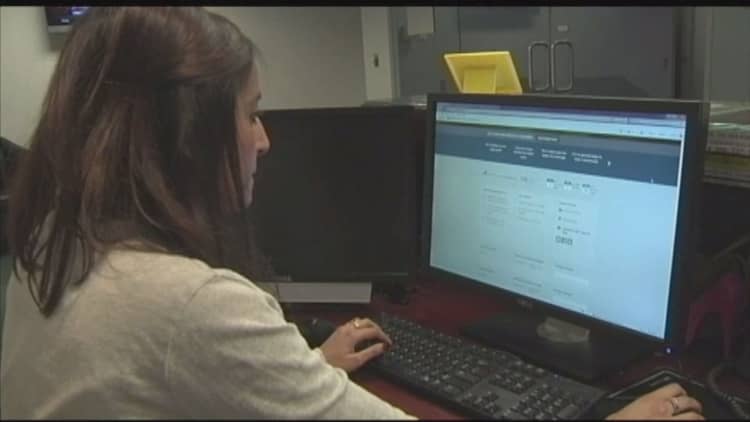
If you get a bad case of sticker shock when you check out the prices of Obamacare plans for next year, there's medicine available for a lot of you to ease the price pain.
Window shopping for health plans sold on the federal Obamacare marketplace HealthCare.gov began Monday, with retail prices of those plans up significantly higher on average than in past years.
But federal health officials were quick to note that the overwhelming majority of Obamacare customers qualify for financial aid that can sharply cut the amount they pay in premiums.
"We're certainly encouraging people to come in and shop and see what options there are for them," said Kevin Griffis, assistant secretary for public affairs at the U.S. Health and Human Services Department.

The average premium, or monthly enrollment payment, for a closely watched type of Obamacare plans are set to rise by an average of 25 percent in the 39 states served by HealthCare.gov, officials revealed Monday. Half of HealthCare.gov consumers will see benchmark plan premiums rise by 16 percent or more, while the other half will see rates rise less than that for such plans.
Among HealthCare.gov states, the highest premium hikes is a stunning 116 percent increase in Arizona, where a 27-year-old who did not qualify for financial aid would go from paying an average of $196 per month for his "benchmark" plan this year up to $422 per month for the same type of plan next year. The lowest increase is a 2 percent hike in New Hampshire, where the benchmark plan for a 27-year-old would go from $215 per month to $217.
Indiana will actually see a 3 percent price drop of its average benchmark plans, with prices falling from $235 per month to $229 for that 27-year-old.
But most other HealthCare.gov states are seeing double-digit price hikes in premiums for their benchmark Obamacare plans, which, like all other individual plans, go on sale Nov. 1 for 2017 coverage.
The higher prices reflect the fact that many insurers lowballed their premiums when they began selling Obamacare plans in 2014, and since then have experienced a wave of customers who cost more in health benefits than had been projected.
But, "thanks to financial assistance, most marketplace consumers this year will find plan options with premiums between $50 and $100 per month," said HHS Secretary Sylvia Burwell.
HHS, in an analysis released Monday, found that 72 percent of HealthCare.gov customers would be able to find a plan that would cost them less than $75 per month after financial assistance.
And 77 percent of customers will be able to find plans that cost them less than $100 per month, after assistance.
The assistance is available to low- and moderate-income people — ones who earn between 100 percent and 400 percent of the federal poverty level. Officials said Monday that the typical HealthCare.gov consumer earns 165 percent of the poverty level, or about $40,000 for a family of four, or $19,000 for a single person.
About 85 percent of current HealthCare.gov customers qualify for financial aid, in the form of federal tax credits.
However, people who earn too much for the subsidies, or who buy individual health plans sold outside of government-run Obamacare marketplaces such as HealthCare.gov, are not eligible for help with their premiums.
The value of the tax credits is linked to the price of Obamacare benchmark plans, regardless of whether an eligible customer actually enrolls in that plan or another plan. And because of the way those credits are calculated, if a customer enrolls in a plan that costs the same or less than the benchmark plan, they will be shielded from the effects of the price hikes.
The benchmark plans are the second-lowest-cost "silver" plans in a consumer's region. Silver plans, the most popular type of Obamacare coverage, on average cover 70 percent of their customers' health costs, with enrollees being responsible for paying the remaining share out of pocket, in the form of deductibles, co-payments and co-insurance.
Officials said Monday that HealthCare.gov consumers would have an average of 30 different insurance plans to choose from, giving them a range of price points and coverage options to select. There will be an average of 10 plans per insurer.
However, residents of some states will have fewer plans to chose from, with states like Arkansas, Oklahoma, Wyoming and Alabama having just one insurance company offering plans.
Officials said that 21 percent of consumers on HealthCare.gov would have just one insurer to choose plans from.
A number of health insurers have cut back their presence in Obamacare markets for 2017, including UnitedHealthcare, Aetna, and Cigna. The number of issuers in HealthCare.gov states this year was 232, but that is shrinking to 167 next year.
Open enrollment in Obamacare plans runs through Jan. 31, 2017.
Under the Affordable Care Act, most Americans must have some form of health coverage during the year, or be subject to a fine that is equal to the the higher of 2.5 percent of household income, or $695.
HHS Secretary Burwell said last week that she expects about 13.8 million people to sign up in plans sold on HealthCare.gov and on state-run Obamacare exchanges by the end of open enrollment. That's just 1.1 million more than the number of people who signed up in exchange-sold plans during open enrollment for 2016.


